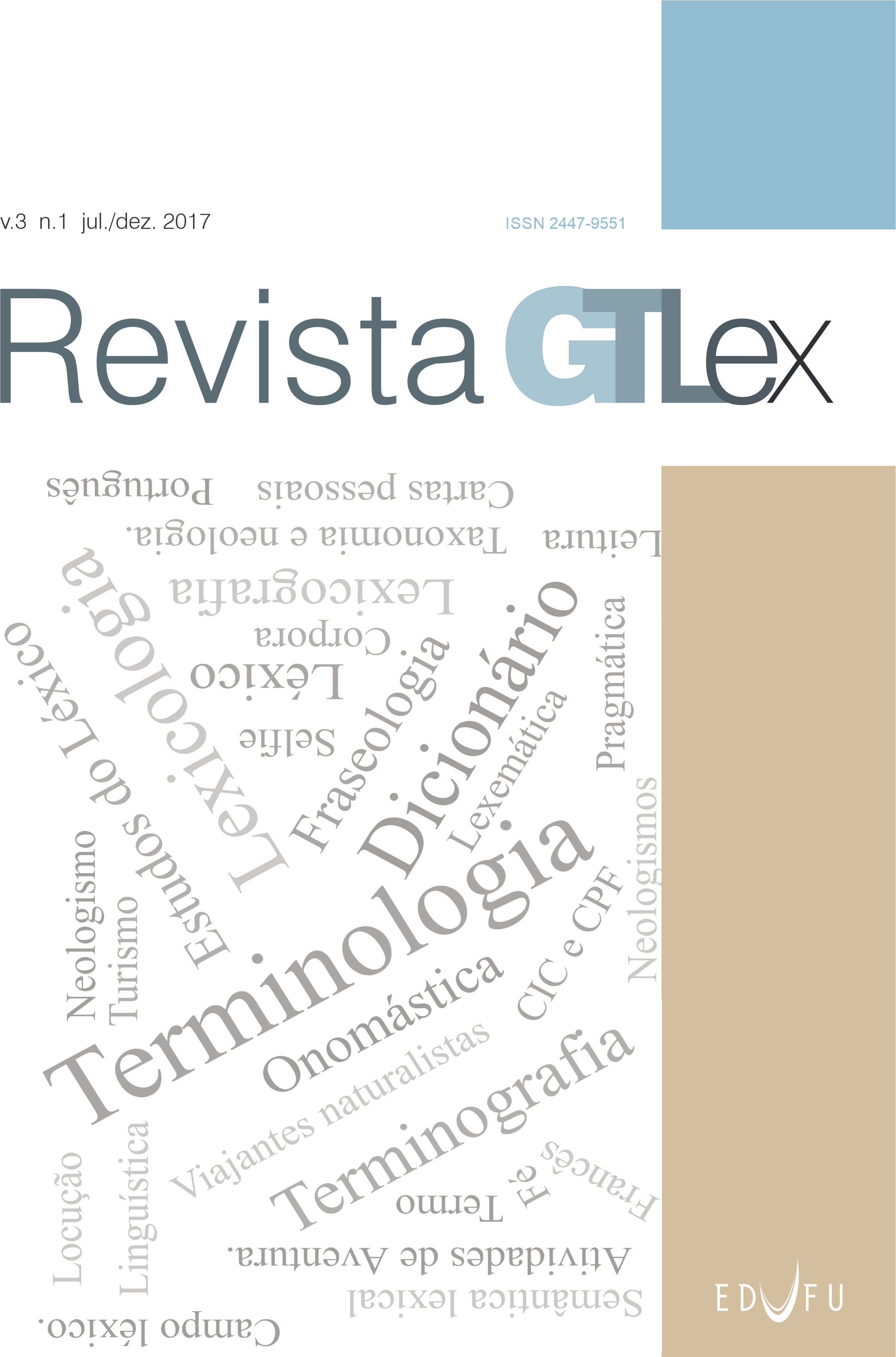Toponímia rural de acidentes humanos do Mato Grosso do Sul
motivações toponímicas e estruturas sintagmáticas
DOI:
https://doi.org/10.14393/Lex5-v3n1a2017-4Palavras-chave:
Toponímia rural, Topônimo, Fazenda, Motivação, Estrutura sintagmáticaResumo
Este trabalho discute resultados parciais da pesquisa em desenvolvimento que tem como objetivo mais amplo descrever e analisar a toponímia rural de acidentes humanos do Mato Grosso do Sul em termos motivação e de estrutura linguística. Neste artigo examinam-se topônimos compostos que nomeiam fazendas localizadas na mesorregião Centro-Norte do Estado do Mato Grosso de Sul, que abrange as microrregiões do Alto Taquari e de Campo Grande, com 16 municípios. O corpus relativo a essa área geográfica extraídos do Sistema de Dados do Projeto Atems[1] e dos mapas oficiais do IBGE escala 1:100.000 (2010) totalizou 1.113 designativos que foram analisados, segundo a motivação, seguindo o modelo taxionômico de Dick (1992, p. 31-34), e conforme os constituintes sintáticos[2] dos topônimos compostos com base em Neves (2000). Os resultados do estudo mostraram que os nomes de fazendas de estrutura composta evidenciam predominantemente as seguintes estruturas dos sintagmas: (Det. Num. + SN) “Dois Irmãos”; (SN+SN) “Maria Augusta”; (SN+ SA) “Terra forte”. Em termos de motivação, dentre as taxionomias de natureza física predominaram os hidrotopônimos, o que denota a influência do ambiente físico na nomeação das propriedades rurais, enquanto entre as taxionomias de natureza antropocultural destacaram-se os nomes de cunho religioso, os hagiotopônimos, atestando, assim, que o ambiente social e cultural do grupo, como a religiosidade reflete-se na nomeação de fazendas da região estudada. Para o estudo utilizam-se como referencial teórico, fundamentalmente, as contribuições de Dick (1990; 1992; 1997; 1998; 1999); de Sapir (1961) e de Neves (2000).
Downloads
Referências
ANANIAS, A. C. C. S. dos. Marcas de religiosidade na toponímia Paranaense. 2018. 372f. Tese (Doutorado em Estudos da Linguagem) – Centro de Letras e Ciências Humanas, Universidade Estadual de Londrina, Londrina, 2018.
ATEMS – Atlas Toponímico de Mato Grosso do Sul. Sistema de Dados. Campo Grande: UFMS, 2019 (uso restrito).
BIDERMAN, M. T. C. Unidades complexas do léxico. In: RIO-TORTO, G.; FIGUEIREDO, O. M.; SILVA, F. (org.). Estudos em homenagem ao Professor Doutor Mário Vilela. 1ª ed., v. II, Porto, Portugal: Faculdade de Letras da Universidade do Porto, 2005. p. 747-757.
CARVALHO, A. P. M. A. de. Hagiotoponímia em Minas Gerais. 2014, 822f. Tese (Doutorado em Linguística Teórica e Descritiva). Faculdade de Letras, Universidade Federal de Minas Gerais, Belo Horizonte, 2014.
DICK, M. V. de P. A. A motivação toponímica e a realidade brasileira. São Paulo: Edições Arquivo do Estado, 1990.
DICK, M. V. de P. A. Toponímia e Antroponímia no Brasil. Coletânea de estudos. São Paulo: Serviço de Artes Gráficas/FFLCH/USP, 1992.
DICK, M. V. de P. A. O léxico toponímico: marcadores e recorrências lingüísticas. (Um estudo de caso: a Toponímia do Maranhão). In: Revista Brasileira de Linguística. São Paulo, v. 8, n. 1. p. 59-68, 1995.
DICK, M. V. de P. A. A dinâmica dos nomes na cidade de São Paulo: 1554-1897. 2ª. ed. São Paulo: Annablume, 1997.
DICK, M. V. de P. A. Os nomes como marcadores ideológicos. Acta Semiótica et Lingüística. João Pessoa/PB, v. 7, n. 1, p. 97-122, 1998. Disponível em: http://www.periodicos.ufpb.br/ojs/index.php/actas/article/view/16907. Acesso em: 28 jul. 2019.
DICK, M. V. de P. A. Métodos e questões terminológicas na Onomástica. Estudo de caso: o Atlas Toponímico do Estado de São Paulo. Investigação. Linguística e Teoria Literária, Recife/UFPE, v. 9, p. 119-148, 1999.
IBGE. Mapas Municipais Censo Demográfico (2010) escala 1:100.000. Disponível em: ftp://geoftp.ibge.gov.br/cartas_e_mapas/mapas_para_fins_de_levantamentos_estatisticos/censo_demografico_2010/mapas_municipais_estatisticos/ms/. Acesso em: 29 jul. 2019.
ISQUERDO, A. N. Léxico regional e léxico toponímico: interfaces linguísticas, históricas e culturais. In: ISQUERDO, A. N.; SEABRA, M. C. T. C. (org.) As ciências do léxico. Lexicologia, Lexicografia, Terminologia. Vol. VI. Campo Grande: Editora da UFMS, 2012, p. 115-139.
ISQUERDO, A. N.; DARGEL, A. P. T. P. Projeto ATEMS: parâmetros metodológicos. In: ISQUERDO, A. N. TOPONÍMIA. Tendências toponímicas no estado de Mato Grosso do Sul. Vol. II, Campo Grande: Editora UFMS, 2019, p. 19-64. Série Toponímia.
NEVES, M. H. M. Gramática de usos do Português. São Paulo: Editora UNESP, 2000.
ROCHA LIMA, C. H. da. Gramática normativa da língua portuguesa. 26a. ed. Rio de Janeiro: José Olympio, 1985 [1915].
SAPIR, E. Linguística como ciência. Rio de Janeiro: Livraria Acadêmica, 1961.
TAVARES, M. Toponímia das localidades rurais do município de Dourados (MS). Revista do Gel. v. 12, São Paulo: UFSCar, p. 164-191, 2005.
Downloads
Publicado
Edição
Seção
Licença
Autores que publicam nesta revista concordam com os seguintes termos:
CC BY-NC-ND 4.0: Autores mantém os direitos autorais e concedem à revista o direito de primeira publicação, com o trabalho simultaneamente licenciado sob a Creative Commons Attribution License que permitindo o compartilhamento do trabalho com reconhecimento da autoria do trabalho e publicação inicial nesta revista.
Autores têm autorização para assumir contratos adicionais separadamente, para distribuição não-exclusiva da versão do trabalho publicada nesta revista (ex.: publicar em repositório institucional ou como capítulo de livro), com reconhecimento de autoria e publicação inicial nesta revista.








